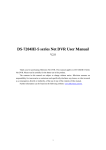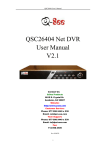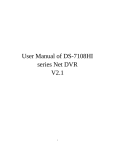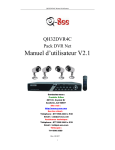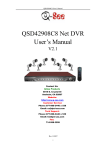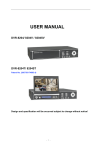Download User Manual of the DS-7108HI-S
Transcript
DS-7108HI-S series Net DVR User Manual DS-7108HI-S series Net DVR User Manual V2.0 Thank you for purchasing our Net DVR. This manual is applicable to DS-7108HI-S Series Net DVR. Please read this User Manual carefully to ensure that you can use the device correctly and safely. The contents of this Manual are subject to change without notice. 1 DS-7108HI-S series Net DVR User Manual Index Chapter1 Product Introduction ......................................................................................................... 4 1.1 Overview ................................................................................................................................. 4 1.2 Model Description................................................................................................................... 4 1.3 Features ................................................................................................................................... 4 Chapter2 Installation......................................................................................................................... 6 2.1 Checking the DVR and Its Accessories .................................................................................. 6 2.2 HDD Installation ..................................................................................................................... 6 2.3 Rear Panel Description............................................................................................................ 7 Chapter3 Operating Instructions ....................................................................................................... 8 3.1 Front Panel Introduction ......................................................................................................... 8 3.2 IR Remote Control .................................................................................................................. 9 3.3 Menu Description .................................................................................................................. 11 3.3.1 Menu Items ......................................................................................................... 11 3.3.2 Menu Operation .................................................................................................. 12 3.4 Input text ............................................................................................................................... 14 Chapter4 Basic Operation Guide .................................................................................................... 15 4.1 Power on ............................................................................................................................... 15 4.2 Preview ................................................................................................................................. 15 4.3 Video spot output .................................................................................................................. 17 4.4 User name and password....................................................................................................... 17 4.5 PTZ Control .......................................................................................................................... 20 4.6 Manual Record ...................................................................................................................... 21 4.7 Playback ................................................................................................................................ 22 4.8 Backup Recorded Files ......................................................................................................... 25 4.9 Shut down DVR .................................................................................................................... 26 Chapter5 Parameters Setup Guide .................................................................................................. 27 5.1 Administrator and Password ................................................................................................. 27 5.2 Add and Delete User ............................................................................................................. 28 5.3 Unit Name and Device ID ..................................................................................................... 31 5.4 Video Output Standard and VGA Setup ................................................................................ 33 5.5 Camera name and OSD Setup ............................................................................................... 33 5.6 Video Parameters Setup ........................................................................................................ 35 5.7 Mask Area Setup ................................................................................................................... 36 5.8 View Tampering Alarm ......................................................................................................... 37 5.9 Video Loss Alarm.................................................................................................................. 39 5.10 Motion Detection .................................................................................................................. 40 5.11 Preview ................................................................................................................................. 42 5.12 Recording Setup .................................................................................................................... 43 5.13 External Alarm Input and Relay Output................................................................................ 46 5.14 Network Parameters .............................................................................................................. 50 5.15 PTZ ....................................................................................................................................... 53 Chapter6 Utilities ............................................................................................................................ 57 2 DS-7108HI-S series Net DVR User Manual 6.1 Restore Parameters ................................................................................................................ 57 6.2 Upgrade ................................................................................................................................. 57 6.3 Hard Disk Management ........................................................................................................ 58 6.4 Stop Alarm Out ..................................................................................................................... 59 6.5 Reboot ................................................................................................................................... 59 6.6 Power Off .............................................................................................................................. 59 6.7 View Log ............................................................................................................................... 59 6.8 System Information ............................................................................................................... 61 Chapter7 Firmware Upgrade .......................................................................................................... 62 7.1 FTP Server Setup .................................................................................................................. 62 7.2 Upgrade Mode ...................................................................................................................... 64 Appendix A Mouse control function ............................................................................................ 67 Appendix B HDD Capacity Calculation ..................................................................................... 69 Appendix C DVR Connect Cable Definition .............................................................................. 70 Appendix D Specifications .......................................................................................................... 72 Appendix E Troubleshooting ...................................................................................................... 73 Appendix F Product Service ....................................................................................................... 74 Appendix G Customer Information Card .................................................................................... 75 3 DS-7108HI-S series Net DVR User Manual Chapter1 Product Introduction 1.1 Overview DS-7108HI-S series network digital video recorder is an excellent digital surveillance product. It adopts the embedded MCU and Linux, along with the most advanced technology in the Information Industry such as video and audio encoding/decoding, hard disk record and TCP/IP function. The firmware is burned into the flash, making the product more stable and reliable. DS-7108HI-S series device combines the features of both digital video recorder (DVR) and digital video server (DVS). It can be used as a standalone video surveillance product, as well as to build a powerful surveillance network that is widely used in the fields of banks, telecommunication, transportation, factories, warehouse, irrigation, etc. 1.2 Model Description DS – 71 08 H I -S Support SATA HDD Oversea products Model name 8 channels video input Embedded Net DVR series Digital Surveillance 1.3 Features Compression H.264 video compression algorithm and each channel can be real-time (PAL is 25FPS and NTSC is 30FPS). Support multi-area motion detection. Support privacy mask. Support view tampering alert. Support video signal loss alert. Support adjustable OSD. Support both variable bit rate and frame rate. 4 DS-7108HI-S series Net DVR User Manual Support dual-stream and the sub stream can support CIF/QCIF resolution. Storage function: 2 SATA interfaces, Each HDD max support 2000GB capacity. Support HDD S.M.A.R.T function. Support FAT32 files system Support various record types: schedule recording, motion detection, alarm, motion & alarm, motion | alarm, command, and manual recording. Support cycle and non-cycle recording mode. Support SATA CD/DVDRW, USB disk, USB hard disk and USB CD/DVD R/W for backup Preview & Playback function: Support one composite video output and one spot video output DS-7108HI-S can support one VGA output. Support fast playback, slow playback, pause, forward, backward and frame-by-frame, etc. User-defined preview layout. Support one playback channel. Network function: Support TCP, UTP, RTP, Multicast, DHCP, etc Support ADSL (PPPoE) dialup function. Remote parameters setup Remote playback, download the recorded files in DVR. Remote DVR firmware upgrade Remote PTZ control Support Internet Explore for network control Remote DVR alarm information acquisition Others: Support network voice talk. Support local and remote PTZ control. Support multi-level user management. Support local and remote log query. Automatically recovery from exceptions Provide SDK and demo source code for development. 5 DS-7108HI-S series Net DVR User Manual Chapter2 Installation Warning: Before you install the DVR, please make sure that the power of DVR is switched off. 2.1 Checking the DVR and Its Accessories When you get the product, check that all the goods are included in your product package. There is a list in the package. If any of the goods is missing, please contact your dealer. 2.2 HDD Installation Installation notice Note: A factory recommended HDD should be used for this device. There is no HDD in the DVR when leaving factory. According to the record schedule, you can calculate the total capacity you need (refer to Appendix A). Please ask the specialist to disassemble the DVR and install HDD. Installation instrument One cross screw driver HDD installation 1. Open the DVR box. 2. Place the HDD on the mounting plate. 3. Connect the SATA data cable correctly. First put the power plug of the HDD in the motherboard. Plug the data line of the HDD into the SATA interface. 4. Fix the HDD into the Chassis. 5. Cover and fix the DVR box. Note: After the HDDs installation, you must format them. Please refer to chapter 6.3 6 DS-7108HI-S series Net DVR User Manual 2.3 Rear Panel Description 2 1 7 8 3 12 6 11 9 4 5 10 Fig 2-1 DS-7108HI-S Rear panel Notice: Please refer to real product for different models. DS-7108HI-S ① Video in ② Video out ③VGA interface ④ Alarm in ⑤Alarm out ⑥ Power switch ⑦Audio in ⑧Audio out ⑨UTP interface ⑩RS485 T+ T- R+ R⑪RS232 interface ⑫Video loop output ⑬+12V DC power supply 7 13 DS-7108HI-S series Net DVR User Manual Chapter3 Operating Instructions 3.1 Front Panel Introduction 6 2 3 1 4 5 Fig 3.1 Front panel introduce Form 3-1 Items on front panel Index Type Name Description 1 Lamp PWR Red means the system power off and green means the contrary. 2 State Lamps READY Green means DVR is working; Extinguish means DVR is power-off Green means you can IR remote control, and red means working in “numeric keys” mode while light out means work in “function keys” mode Red means there is alarm(only triggered by external alarm input) Twinkle in red means reading or writing HDD Twinkle means network transmission is happening. STATUS ALARM RECORD NETWORK Numeric Keys 3 Function Keys Input number, lower case, upper case, number and symbols. MENU 1. 2. 2 3 [ZOOM-] in PTZ control. 1. [ZOOM+] in PTZ control. 2. Switch to spot output mode Cancel and back to the menu. 1. In edit state, delete the current cursor character; 2. [IRIS+]in PTZ control; ESC EDIT Switch preview mode to menu; Brush control short key [WIPER]. 8 DS-7108HI-S series Net DVR User Manual PLAY REC PTZ PREV A SHIFT 4 Control Keys Direction Keys ENTER Select or × to enable or disable. Local playback; [AUTO] in PTZ control. Manual record; [SHOT] in PTZ control (adjust preset). Enter PTZ control mode; [IRIS-] in PTZ control. Multi- screen preview; Switch the menu to preview mode; [FOCUS-] in PTZ control. Input (number, lower case, upper case and symbol) switch; 2. [FOCUS+]in PTZ control; 3. In preview mode, display or hide the channel status bar. Switch between numeric keys and function keys 3. 1. 2. 1. 2. 1. 2. 1. 2. 3. 1. Composed of [], [], [] and []. 1. Menu mode, use[]/[] and []/[] to move; 2. PTZ direction control; 3. Playback speed control. 1. Menu confirmation; 2. Select or × to enable or disable; 3. Pause playback. 5 Physical interface physical interface for USB 6 IR receiver Received IR signal from IR remote control 3.2 IR Remote Control 9 DS-7108HI-S series Net DVR User Manual Fig. 3.2 IR remote control Form 3-2 Instruction of IR Index Name Description 1 POWER Turn off device. 2 DEV Enable IR remote control 3 Numeric Keys Same as numeric keys of front panel. 4 EDIT Same as EDIT key of front panel. 5 A Same as A key of front panel. 6 REC Same as REC key of front panel. 7 PLAY Same as PLAY key of front panel. 8 INFO Reserved 9 VOIP Reserved 10 MENU Same as MENU key of front panel. 11 PREV Same as PREV key of front panel. 12 Direction Keys ENTER Same as direction keys and enter key of front panel. 13 PTZ Same PTZ key of front panel. 14 ESC Same as ESC key of front panel. 10 DS-7108HI-S series Net DVR User Manual 15 Reserved 16 F1 Light 17 Lens control IRIS, FOCUS ZOOM for lens control.(“ZOOM+” is also used to switch spot output mode) 18 F2 reserved Placing the batteries into the IR control 1. 2. 3. Open the battery cover. Insert the battery. Please make sure that the poles (+ and -) are correctly placed. Fold the battery cover. Start to use IR control Switch the device power on, wait without any operations until preview screen appears, then you can use IR control managing DVR, and the default ID of device is “255”, which can be changed in “Display” menu. If the default device ID has been changed, please press [Power] & [DEV] key of IR control, input the present device ID and then press [ENTER] key. Then you can use IR control to operate this DVR. Note: When you use IR remote control to control a device which has a device ID 255, the corresponding STATUS light is off, but you still can control it. Stop using IR control When IR control status is on, press [DEV] key again, then the IR control cannot control this DVR. Switch the DVR off When IR control is working, please press [POWER] key for several seconds, the power-off prompt will pop-up, confirm it and shut down the power manually. When IR control cannot work normally Check batteries poles. Check the remaining charge in the batteries. Check IR control sensor is masked. Please change another IR control and try again. If the problem still exists, please contact administrator. 3.3 Menu Description 3.3.1 Menu Items Form 3-3 First Glance at menu 11 DS-7108HI-S series Net DVR User Manual Menu Name Display Recording Alarms User 3.3.2 Function Menu Name Device ID Require password Screen saver Video standard Enable scaler Brightness Menu transparency VGA resolution Date/Time Preview Camera If HD Full Select camera Stream type Resolution Frame rate Bit rate Enable Rec PreRec time PostRec time Copy to camera Network Select Alarm in Alarm type Alarm Handling & policy & PTZ linkage Copy to alarm in Alarm out & time Copy to alarm out Exceptions PTZ Add/Delete Password/Verify Default Privileges Set Privileges Utilities Menu Operation How to enter the menu mode Press [MENU] key to enter the DVR main menu. 12 Function Select camera Name Color Date OSD Motion Det. Level Advanced Settings Copy to camera IP Port Mask Gateway Http Port Advanced Settings PPPoE Select Camera Baud Rate & Data Bits Stop Bits & Parity Flow ctrl & Protocol PTZ Addr. & Preset Sequence No. & Cruise Copy to Camera RS232 Default parameters Firmware Hard Disk Alarm output Reboot Power off View log System information DS-7108HI-S series Net DVR User Manual Press [PLAY] short key to enter the playback menu. Press [REC] short key to enter the manual record menu. Press [PTZ] short key to enter the PTZ control interface. Notes: You must input user name and password. The default user name is “admin” and password is “12345”. Main Menu Description The main menu interface is shown as Fig.3.3 below: Fig. 3.3 Main menu There is one small frame named “Active Frame”. It can be moved from one item to another by using direction keys ([↑] [↓]). When the “Active Frame” is located on one icon, you can press [ENTER] key to enter the sub menu. For example, move the “Active Frame” to “Camera” icon, press [ENTER] to enter the sub menu as follows Fig.3.4 below: 13 DS-7108HI-S series Net DVR User Manual Fig. 3.4 Camera input adjustment Each menu contains different kinds of items. There is a small rectangular frame named “Active Frame” which is pointing to the selected item. This “Active Frame” can be moved by direction keys ([↑] [↓][←][→]). There are several kinds of menu items as follows: 1. Check Box: Provides two options, “” means enable and “×” means disable. You can use [ENTER] or [EDIT] key to switch over. 2. List Box: Provide more than 2 options. Only one of them can be selected. After pressing [EDIT] you can use [↑] and [↓] to select one option. For example, on the right side of “Select Camera”, there is a list box for you to select one camera. 3. Edit Box: This is for you to input characters. Press [EDIT] key to enter the edit status, you can input text there: a) Press [A] key to select number, upper case, lower case or symbols; b) Use [→] and [←] keys to move cursor; c) Use [EDIT] key to delete the character in front of cursor; d) Press [ENTER] to save & [ESC] to exit without saving. 4. Button: Trigger a special function or enter the next sub-menu. For example, press “Policy” button to enter the sub-menu. Press [Confirm] to save parameters and return to main menu. Press [Cancel] button to cancel and return to main menu. The button in grey means it can be operated only after being enabled. How to exit menu Press [PREV] key to exit menu and return to preview mode. Also you can press [ESC] key to exit sub-menu as well as main menu. 3.4 Input text In the menu interface, if in edit status (for example, in the “camera name” edit box), at the bottom of screen, the input status is appeared as follow: Here it means you can press numeric keys to input digital number. Press [A] key to change input ways. You can select “number”, “Uppercase”, “Lowercase” or “Symbol”. Uppercase Lowercase Symbol There are 24 symbols in all. They are divided into 4 pages, and you can press [SHIFT] and then use [0] key to turn over pages. 14 DS-7108HI-S series Net DVR User Manual Chapter4 Basic Operation Guide 4.1 Power on Note: Please make sure that the power supply matches DVR and DC adapter is connected correctly. Before switching DVR on, please connect one monitor through VOUT or VGA interface. Otherwise, you cannot see graphic user interface and operate. If [POWER] lamp is off, please do as follows: Step1: Connect power supply correctly; Step2: Switch on the power button on the rear panel. When DVR is started, [POWER] lamp is green. If the HDD is not installed or detected, the information “No Disk A ×” will be seen in the lower right corner of the preview screen. 4.2 Preview DVR will enter the preview mode after started. On preview screen, you can see date, time, and camera icon. Set system date and time in “Camera” → “Date OSD” menu; Change camera name in “Camera” menu, please refer to 5.5 On the screen, you will see record and alarm status of each camera. Shown as Fig. below, these two kinds of status will alternate automatically. Press [A] key to display or hide the camera status bar. Fig. 4.1 Recording Status 15 DS-7108HI-S series Net DVR User Manual Form 4-1 Camera record status Icon Icon Color Status Description White No video signal Yellow Video input Pink Manual recording Green Continuous recording Blue Motion detect recording Red External alarm recording Fig. 4.2 Alarm status Form 4.2 Camera alarm status Icon Icon Color Status Description White Video signal loss Yellow View tampering alarm Pink Motion & External alarm 16 DS-7108HI-S series Net DVR User Manual Green No alarm Blue Motion alarm Red External alarm Press numeric keys to switch individual camera preview in SHIFT mode. For example, you can press [2] key to preview 2nd camera. Press [EDIT] key to manual cycle preview. You also can set the auto preview mode in “Preview” menu, referring to 5.11. Press [PREV] key to switch multi-screens preview. 4.3 Video spot output Make sure that the numeric button is in “function” mode (the status lamp is off), Press [shift] button to switch numeric button between “numeric” mode and “function” mode. Step1: Connect Video out 2 with monitor by a cable. Step2: Press [3] to enter the spot out mode. Step3: Press [shift] to enter the numeric mode Step4: Press [1] to [4] button to switch video spot output from channel 1 to channel 4 Note: make sure that there is video signal input; otherwise spot out will be only shown as blue screen. 4.4 User name and password Note: When DVR is delivered from factory, there is only one default administrator named “admin”, and password is “12345”. The administrator’s name cannot be modified, while the password can be modified. The administrator can create 15 users and define their operating rights. Login Login dialog as shown Fig.4.3 below 17 DS-7108HI-S series Net DVR User Manual Fig. 4.3 Login dialog Use []/[] keys to select one user, press[]key to enter “Password” edit box, input corresponding password, press[ENTER]key to exit edit box. The “Active Frame” will move to “Confirm” button. Press [ENTER] key and enter main menu. If there is buzzing alarm, it means the user name and password are not matched. After three times errors, DVR will enter the preview mode. Modify password For those users created by admin, they can modify their passwords as follows: Step1: Enter main menu Press [MENU] key, in the login dialog, select your user name, input the correct password, you can enter the main menu. As shown in Fig.4.4 and Fig.4.5 below. Fig. 4.4 Input passwords 18 DS-7108HI-S series Net DVR User Manual Fig. 4.5 Main menu Step 2: Select the target user name by using [↑]/[↓], then move the “Active Frame” to “Password” icon by using[]/[]keys. As shown in Fig.4.6 below. Fig. 4.6 Modify user’s password Step 3: Input new password Use numeric keys to input new password. The password can be null. It also can be 16 numerals. Press [ENTER] to exit edit box, and move to “Verify” item to verify password. Note: In edit box, use []/[]to move cursor and[EDIT]key to delete the numeral in front of the cursor. Step 4: Modify password successfully Move the “Active Frame” to “Confirm” button, press [ENTER] key. If the password is modified successfully, you will turn to the main menu. Or an error dialog will pop up. You can repeat step 3 to modify again. 19 DS-7108HI-S series Net DVR User Manual 4.5 PTZ Control Note: The user must have the “PTZ control” right. PTZ control interface In menu mode, press [PTZ] key, you can enter the PTZ control interface directly. In preview mode, press [PTZ] key, in the login dialog, select one user name and input the correct password, you can enter PTZ control interface. As shown in Fig. 4.7 below. Fig. 4.7 PTZ Control interface The position where current camera name displays can be user-defined. Select channel In PTZ control mode, you can press numeric keys under SHIFT mode to select channel. For example, you can press [2] key to select the 2nd camera PTZ. After you select the camera PTZ, you can use the control keys to control PTZ. Description of PTZ control keys in IR remote control Direction control keys: ZOOM control keys: FOCUS control keys: IRIS control keys: Adjust preset keys: Auto control key: Wiper control key: Light control key: [↑], [↓], [←], [→]; [ZOOM+], [ZOOM-]; [FOCUS+], [FOCUS-]; [IRIS+], [IRIS-]; [REC]; [PLAY]; [MENU/WIPER]; [F1]. Adjust preset description In PTZ control mode, press [REC] key, and press the preset number (three numeric keys), 20 DS-7108HI-S series Net DVR User Manual DVR will adjust the corresponding preset number. Repeat pressing [REC] key, and press the preset number, DVR will adjust that preset number. When you exit PTZ control mode, the camera will stay at the current position. Note: The PTZ preset number is set already. Please refer to PTZ menu for preset setup. V2.0 firmware can support 128 preset at most and the number of preset may 96 when you use the USB mouse to call them Start/Stop auto function in PTZ control mode In PTZ control mode, press [PLAY] key to start PTZ auto function. Press [PLAY] key again to stop. When PTZ is in auto mode, if you exit PTZ control mode, PTZ will continue auto function unless you enter the PTZ control mode again, and press [PLAY] key to stop. Exit PTZ control mode Press [ESC] or [ENTER] to exit and return to the preview mode. 4.6 Manual Record Note: The user must have the corresponding right, DVR has HDD and HDD is formatted already. Manual record In preview mode, press [REC] key, in the pop-up login dialog, select the name and input the correct password, you can enter the “Manual Record” interface. In menu mode, press [REC] key to enter the “Manual Record” interface directly. Fig. 4.8 Manual record interface Description Manual record interface has follows parts: channel number, channel status, start/stop record, start all and stop all buttons. 21 DS-7108HI-S series Net DVR User Manual Channel: List the channel number DVR has. Status: Channel work status has 4 cases: means idle. Green means the channel is recording (including real time recording, alarm recording, motion detection recording). Red means network transmission. Orange means both recording and network transmission. Start/Stop: “” means you can start corresponding channel recording. “×” means you can stop recording. Start All: Press this button to start all channels recording. Stop All: Press this button to stop all channel recording. Press [ESC] key to enter the preview mode. Press [MENU] key to enter main menu. Press [PLAY] key to enter the playback menu. Press [PTZ] key to enter the PTZ control mode. 4.7 Playback Note: The user must have “Playback” right. Playback interface In preview mode, press [PLAY] key, in the pop-up login dialog, select user name and input correct password, you can enter the “Playback” interface. In menu mode, press [PLAY] key, you can enter the “Playback” interface directly. Shown as Fig. 4.9 below Fig. 4.9 Playback operate interface Description Select a Channel: Move the “Active Frame” to “chan”, press “edit” button, then use [↑] or [↓] key to select a channel. Rec Type: Use [↑] or [↓] to select recorded files type. The file type options have “All”, “All Time”, “Motion Detect”, “Alarm” and “Manual”. Time Section: You can define the search time section. Move “Active Frame” to the time edit box, use numeric keys to input the detail time. 22 DS-7108HI-S series Net DVR User Manual Search: Search the matched recorded files and display them in the list box. If there is not matched file, a corresponding dialog box will be pop-up. Play by Time: Playback the recorded stream directly based on the time section. Select Page: In the file list box, each page will only display 8 files. If the matched files are more than 8, you can select page to list other files. 500 pages (4000 files) can be searched in one time. You can use numeric keys or [↑] [↓] keys to select page. File List Box: List the matched files. File started time, file size are displayed in the list box. You can use [↑] [↓] keys to move the scroll bar to select file. Backup Devices: You can select USB flash, USB HDD, USB CD-R/W to backup the files or clips. Copy: Start to backup. Backup Today: Backup all recorded files of today. Operation when playback Fig. 4.10 Playback interface At the bottom of image, there is an information bar and the following information is included: Volume, Play Progress, Play Speed, Played Time and File Total Time. Display/Hide information bar: [MENU] Open/Close sound: [PLAY] Adjust play progress: [←] (Backward), [→] (Forward). The unit is “%”. Adjust play speed: Normal speed is “1x”. Use [↑] to increase play speed (2X, 4X, 8X and MAX). Use [↓] to decrease play speed (1/2X, 1/4X, 1/8X and single) Pause/Continue: Press [ENTER] to pause/continue playback. If played frame by frame, Press [ENTER] to play one frame. Copy segment: [EDIT]; Stop copy: [EDIT] (Need a back up device to store the segment) Exit: [ESC] Note: When DVR is busy, if you select high play speed, maybe there is difference from actual play speed. Exit playback In playback interface, press [ESC] key to enter the preview mode. 23 DS-7108HI-S series Net DVR User Manual In playback interface, press [MENU] key to enter main menu, press [REC] key to enter the manual record, and press [PTZ] key to enter the PTZ control mode. Playback with mouse plugged If you playback with a mouse plugged, the interface will be a little different. And you can acquire more functions to operate in the playback course. Shown as Fig.4.11 below. Fig. 4.11 Play back control bar There is an additional bar appears. We call it control bar. Control bar descriptions: : You can click these buttons to skip backward or forward 3% each time. : You can click these buttons to select the play speed : Click this button to pause. : Click this button to be mute, click it again to recover the sound. : Click this button to start copy the segment, click it again to stop. : Click this button to hide the control bar, right click your mouse and select display, then the control bar will turn up again. : Click this button will trigger a rectangle area on the screen ,draw the rectangle with left key of your mouse pressed and move to the area you want to zoom in then double click left key to zoom in that place. Click left key again to return to the playback interface. : Click these buttons to switch to previous or next playback 24 DS-7108HI-S series Net DVR User Manual channels. It is useless if you only record one channel at that time. 4.8 Backup Recorded Files Note: The user must have “Playback” right. Please connect the backup devices before you start to backup. In the playback interface, you can backup the recorded files. In the preview mode, press [PLAY] key, in the login dialog, select username and input the correct password, you can enter the playback interface. In the menu mode, just press [PLAY] key, you can enter the playback interface directly. Backup intraday recorded files In the playback interface, move “Active Frame” to “Backup Today” button, press[ENTER]key, all intraday recorded files of all channels will be backup to the storage device. A pop-up dialog will display the backup status. If backup device is not connected correctly or DVR do not detect the backup device, an exception dialog will pop up. Please ask administrator for more information. Backup the files that matched your requirement Step 1: Search the matched files In the playback interface, select one channel and record type, input the time section, move “Active Frame” to “Search” button, press[ENTER]key, DVR will start to find and list the matched files. Step 2: Select the files that you want to backup In the file list box, use [↑] or [↓] keys to move the scroll bar. When the scroll bar stays at the file you want to backup, press [EDIT] key to select it. The symbol “” is the selection tag. You can use the same method to select other files you want to backup. After finish, you can follow the next step. Shown as Fig.4.12 below 25 DS-7108HI-S series Net DVR User Manual Fig. 4.12 Playback list Step 3: Select backup device Please confirm the backup device: USB disk, USB HDD, USB CD-R/W, and select the corresponding backup device. Step 4: Start and finish backup Move “Active Frame” to “Copy” button and you can press [ENTER] key to start to backup. When backup is started, corresponding message box will pop-up to indicate the process. Backup video segment You can also backup the image segments when playback. The steps are: 1) Enter the interface of playback the files or playback by time; 2) Press [EDIT] key to start selecting the current playback image, and press [EDIT] again to stop selecting. This segment is selected; 3) You can repeat step 2 to select many segments. 30 segments can be selected in all; 4) After you select all segments, press [ESC] key, a message window will pop-up. If you press “Confirm” button, DVR will start to backup the selected segments. If you press “Cancel” button, DVR will abort backup. Playback the video segment You can use our file player software to playback the video segment in PC. You can find the player software in attached CD. Exit playback interface Please refer to chapter 4.6. 4.9 Shut down DVR Note: If you just shut down the system, the fan in DVR still will be running except to turn off the power from rear panel directly. 26 DS-7108HI-S series Net DVR User Manual Chapter5 Parameters Setup Guide Only the users who have “Parameters Setup” right need to read this chapter. When the following parameters are modified and saved, you must reboot the DVR to make the new parameters become effective. Others do not need to reboot the device. Any network parameters resolution and record schedule External alarm sensor type View tampering alarm schedule Video loss alarm schedule Motion detection alarm schedule External alarm schedule Alarm output schedule 5.1 Administrator and Password When DVR is left from factory, there is one default administrator. The name is “admin” and password is “12345”. The name cannot be changed while the password can be modified. Password modification Press[MENU]key, in the login dialog, select the username as “admin”, use[→]key, move cursor to password edit box, input “12345”, press “Confirm” to enter the administrator menu. Fig. 5.1 Enter user menu Move “Active Frame” to “User” icon, press [ENTER] key to enter “User Management” menu. Shown as Fig.5.2 below 27 DS-7108HI-S series Net DVR User Manual Fig. 5.2 User management In the user name list box, only “admin” is existed. You can use [→] key, move “Active Frame” to password edit box, and press [EDIT] key to enter edit status. Press numeric keys to input the new password. The password is only combined by 16 numerals at most. After finish inputting password, you need to press [ENTER] key to exit. Move “Active Frame” to “Verify password” edit box, input the verify password. Move “Active Frame” to “Confirm” button, and press [ENTER], if password and verify password are the same, the password will be saved and taken into effective. If password and verify password are not same, a warning message box will pop up. Shown as Fig.5.3 below Fig. 5.3 password error In this case, press [ENTER] to return password edit box, and input new password again. 5.2 Add and Delete User Enter “User Management” interface. Add user The steps are following: 28 DS-7108HI-S series Net DVR User Manual Step 1: Enter “User Management” menu as Fig. below Please refer to chapter 5.1 Fig. 5.4 user management Step 2: Add new user name In the “User Management” menu, move “Active Frame” to “Add” button and press [ENTER], in the pop-up dialog, input the new user name (refer to chapter 3.4), press [ENTER]and return “User Management” menu. Totally 15 users can be added. Shown as Fig.5.5 below Fig. 5.5 Input user name Step 3: Setup the password for new user After you add one new user, the password is null. You can skip over this step if you do not need the password. In the users list box of “User Management” menu, use [] [] keys to select the new user name, then use [] key to the password edit box. Press [EDIT] key to enter edit box, use numeric keys to input the new password. Step 3: Setup the rights for new user The new added user has not any operational rights. You must setup rights for him. In the users list box of “User Management” menu, use [] [] keys to select the new user name, then use [] key to “Default Privileges” button, press [ENTER], the user have the default rights. The default rights include local playback, remote playback and view log. If you want to define the detail rights, move “Active Frame” to “Setup Privileges” button and press [ENTER] to enter rights setup menu as follows: Shown as Fig.5.6. 29 DS-7108HI-S series Net DVR User Manual Fig. 5.6 set user right Operational rights are divided into “Local” and “Remote”. You can assign the necessary rights to the user. Use [] [] key to move “Active Frame” to the corresponding right items, press [ENTER] or [EDIT] key to enable or disable the item. “” means assign the right to that user. Step 4: Save the new user’s password and rights In the “User Management” menu, press “Confirm” button, the user’s password and rights will be saved and return main menu. If you press “Cancel” button, the configuration will be invalid. User rights description “Local”: Local rights are for local operation, such as the operation using front panel, IR control and RS-485 interface. PTZCtrl: Locally control PTZ; Record: Manual start/stop recording; SetPara: Locally setup the DVR parameters; Log: Locally view the log on DVR; Util: Locally RS232 parameters setup, restore parameters, upgrade firmware, format HDD, reboot DVR and shut down DVR, etc. “Remote”: PTZCtrl: Remote control PTZ; Record: Remote manual start/stop recording; SetPara: Remote setup the DVR parameters; Log: Remote view the log on DVR; Util: Remote RS232 parameters setup, restore parameters, upgrade firmware, format HDD, reboot DVR and shut down DVR, etc. 30 DS-7108HI-S series Net DVR User Manual Talk: Client talks with DVR; Alarm: Remote control DVR alarm output; Local Out: Remote control DVR video output; Com Ctrl: DVR RS-232 parameters setup. MAC address This MAC address is not the address of DVR but the address of the PC which will access DVR. If you setup this function, only the PC with this MAC address can access this DVR. At PC terminal, in DOS prompt, you can use “ipconfig” command to get the PC MAC address. Delete user In “User Management” interface, you can use [] [] keys to select one user, then use [] to move “Active Frame” to “Del” button, press [ENTER], in the pop-up confirmation dialog, press “Confirm” button to delete the selected user and return. Press “Cancel” or [ESC] to abort deleting. Shown as Fig.5.7 below Fig. 5.7 Delete user 5.3 Unit Name and Device ID Unit name Enter “Utilities” “System Info” and “Unit Name” will be seen as Fig.5.8 below: 31 DS-7108HI-S series Net DVR User Manual Fig. 5.8 System Info There is an item named “Unit Name”. The default unit name is “Embedded Net DVR”. Move “Active Frame” to unit name edit box, press [EDIT] key to enter edit status, you can modify the unit name. Please refer to chapter 3.4 about how to input characters. Press [ENTER] key to finish modification. Select “Confirm” button and press [ENTER], you can save the new unit name and make it become effective. Press “Cancel” button or [ESC] key to invalidate modification. Device ID: Fig. 5.9 Display menu When using IR control to operate DVR, you must use device ID to select DVR. The default device ID of DVR is “255”. If there are more than one DVR in one place, please define different device ID for each DVR. Otherwise, the IR control will control all DVR with the same device ID at a time. In “Display” menu, move “Active Frame” to the device ID edit box, in the edit status, you can use numeric keys to input new device ID. The device ID value is ranged among 01-255. After you finish the modification, press “Confirm” button to save and take effect or press “Cancel” to invalidate modification. 32 DS-7108HI-S series Net DVR User Manual 5.4 Video Output Standard and VGA Setup Video output standard There is one VOUT BNC connector at the rear panel of DVR. It is used to connect with analog monitor and can support PAL or NTSC video output. You can modify video output standard to match monitor video input. In “Display” menu: There is a list box named “Video Standard”, you can firstly press “EDIT” or “Enter” key and then use [] [] key to select PAL or NTSC video output. VGA setup There is one VGA interface at the rear panel of DVR. You can connect it with VGA display. You can define VGA resolution; refresh frequency in “Display” menu. There are following options: 1280*1024/60Hz, 1024*768/60Hz, 800*600/60Hz. You can use [] [] key to select. Press “Confirm” button to save or “Cancel” to invalidate. 5.5 Camera name and OSD Setup Camera Name In “Camera” menu, you can define name for each camera. Please notice that camera’s name can’t be the same. Shown as Fig.5.10 below Fig. 5.10 Input camera number The steps of camera name setup: Step 1: Select one camera. Step 2: Move “Active Frame” to camera name edit box, press[EDIT]key to enter edit status, you can input digital number, uppercase and lowercase characters (refer to Chapter 3.4). The camera name can support 32 characters. 33 DS-7108HI-S series Net DVR User Manual Step 3: Press [ENTER] key to exit edit status. Move “Active Frame” to “Confirm” button, press [ENTER] to save the modification and you can see the new camera name. Press “Cancel” button or [ESC] key to invalidate. Camera Name Position If you do not want to display camera name, just disable the check box beside camera name edit box. The disable flag is “×”. If you enable the check box, you can setup the camera name position. You can copy the position to any other camera. The setup steps are: Step 1: Enter “Camera” menu. Step 2: Select one camera. Step 3: Enable the check box on the right side of camera name, then you move “Active Frame” to “Position” button, press[ENTER]to enter camera name position setup interface, as picture below in that interface, you can use[][][][]keys to move camera name position. When the position is fixed, press [ENTER] and return “Camera” menu, and press “Confirm” button to save it. In the “Camera” menu, press “Cancel” button or [ESC] key, you can invalidate the modification. OSD is the abbreviation of “On Screen Display”. For our embedded DVR/DVS, it includes displaying system time and camera name. OSD settings include: System time, time format, time display position, camera name, camera name display position, etc. System Time In “Display” menu, you can setup DVR system date and time. Move your active frame to “Date/Time” item, and press enter. Date Display Mode: Move the active frame to Date Display Mode then press [EDIT] then use [↑] [↓] key to select OSD format. There are following OSD formats: MM DD YY MM DD YY YY MM DD YY MM DD Here YY means year, MM means month, DD means day. You can also enable DST (Daylight-saving Time) function here. Shown as Fig.5.11 below Fig. 5.11 Date/time setup Date OSD Position 34 DS-7108HI-S series Net DVR User Manual In “Camera” menu you can adjust the position where you want Date to display, move active frame to “Position” item on the right side of “Date OSD” item and press enter button. Then you will see the picture below. Use [↑] [↓] [←] [→] to adjust the position of date. As Shown Fig. 5.12: Fig. 5.12 Set position of Data & Time 5.6 Video Parameters Setup For different camera and different background, in order to get the best video image, you need to adjust video parameters such as brightness, saturation, contrast and hue, etc. You can setup the camera individually, and also you can copy the video parameters of one camera to any other cameras. Here are the setup steps: Step 1: Enter “Camera”, select a camera then enter “Color setup” menu. Shown as Fig.5.13 below Fig. 5.13 Color setup 35 DS-7108HI-S series Net DVR User Manual Step 2: Select camera: Please use [] [] keys to select one camera. Step 3: Adjust brightness, contrast, saturation and hue: Move “Active Frame” to the “Adjust” button on the right side of Brightness, Contrast, Saturation and Hue, press [ENTER]key, you will enter the corresponding adjust interface. In the adjust interface, there is one scroll bar at the bottom, you can use [] [] keys to adjust and can find the video image will be changed at the same time. When you are satisfied with the real time video image, press [ENTER] to return “Color” menu. Step 4: You can copy the video parameters of current camera to any other cameras. Or you can repeat setp2 and step3 to adjust for any other camera. After adjusting, in “Color Setup” menu, press “Confirm” button to save parameters and make them become effective. Otherwise, press “Cancel” button or [ESC] key to invalidate modification. 5.7 Mask Area Setup In some cases, maybe you want to mask the sensitive area. This area will not be previewed and recorded. The mask area setup steps are following: Step 1: Enter “Camera” menu: Step 2: Select one camera: You can use [] [] keys to select one camera. Step 3: Enter “Advanced settings” enable the check box beside “Privacy Mask” item, you can press [Enter] or [edit] key to change the flag into “”, and active “Area” button. Move “Active Frame” to “Area” button on the right side of mask check box, press[ENTER]key to enter mask area setup interface. Shown as Fig.5.14 below Fig. 5.14 Mask area setup Step 4: Setup mask area: In the mask area setup interface, there is one small yellow pane on 36 DS-7108HI-S series Net DVR User Manual the upper left side. For PAL camera, the whole screen is divided into 22*18 panes (22*15 for NTSC), you can use[↑][↓][→][←]keys to move the yellow pane to your hope position and press[EDIT]key, the yellow pane will be turned into red, then you can use[↑][↓][→]keys to extend the red pane and [←]key to shrink the red pane. This red area is the mask area. After you confirm the red mask area, please press [EDIT] key to save the mask area. The maximum mask area size is 8*8 panes and the minimum size is only one pane. You can setup 4 mask areas at most. After you finish setup, press [ENTER] key to return “Advanced settings” menu. You can press [A] key to clear all mask areas. Step 5: Save mask area: You can repeat step2, step3 and step4 to setup mask area for other cameras. In “Advanced setting” menu, press “Confirm” button to save the mask area, press “Cancel” button to invalidate. Here is the example for mask area function. Shown as Fig.5.15 below Fig. 5.15 Area masked Disable the mask check box means cancel the mask area. 5.8 View Tampering Alarm If you enable this function, when someone blocks the camera spitefully, DVR will sound warning alarm. Step 1: Enter “Camera” menu: Step 2: Select camera: Please use [] [] keys to select one camera. And enter “Advanced Settings”. 37 DS-7108HI-S series Net DVR User Manual Step 3: Select sensitivity: move active frame to sensitivity item right beside the “View tampering” item. Press [edit] key, then you can use [↑] [↓] keys to select the sensitivity for “View Tampering” item. The sensitivity options are: Low, Normal and High. Select one of them will active “Area Setup” and “Policy” configuration. Step 4: View tampering area setup Move “Active Frame” to “Area” button, press [ENTER] key to enter area setup interface. The setup methods are same as that of mask area setup. After you setup the area, press [ENTER] key to return “Advanced settings” menu. You can press [ESC] key to invalidate. Only one view tampering area can be setup, and the size of the area can be full screen. Step 5: View tampering alarm setup In “Advanced settings” menu, move “Active Frame” to “Policy” button, press[ENTER]key to enter “View Tampering Handle” menu: Shown as Fig.5.16 below Fig. 5.16 View tampering handle setup Step 6: Alarm schedule setup: When there is view tampering alarm happened, DVR will handle the alarm based on the schedule. You can set 4 periods for each day one week. Also you can copy the schedule of one day to other days. Notes: Time periods can’t be repeated. Please reboot DVR to make the parameters become effective. Step 7: Setup alarm policy: If there is view tampering alarm happened in schedule, DVR will response based on the policy. You can select one or more solution including “On Screen Warning”, “Audible Warning”, “Upload to Center” and “Trigger Alarm Output”. You can use [↑] [↓] and [EDIT] key to enable or disable them. “×” is disable and “” is enable. Step 8: Save alarm setup: After your setup, press “Confirm” button and return “Image Setup” interface. In “Image Setup” menu, press “Confirm” button to save current camera parameters and return main menu. 38 DS-7108HI-S series Net DVR User Manual Step 9: Save all cameras: If you want to setup other cameras, please repeat from step2 to step 8. In “Image Setup” menu, press “Confirm” key to save all cameras parameters. Press “Cancel” button or [ESC] key to invalidate. Select “Off” option for “View Tampering”, you can delete the view tampering area. Note: Only one view tampering area can be setup for each camera. The view tampering area can’t be copied. If the schedule is modified, you must reboot the device to make the parameters become effective. 5.9 Video Loss Alarm When the video cable or camera has something wrong, the video image is lost. If you enable video loss alarm, in such case, DVR will sound alarm. Step 1: Enter “Camera” menu: Step 2: Select camera: Use [] [] keys to select one camera. Step 3: Enter “Advanced settings” interface: Move “Active Frame” to the handle method box on the right side of “Signal Loss” item, use[]key to select “Handle” option and move “Active Frame” to the “Policy” button on right side. Press [ENTER] to enter “Signal Loss” interface: Shown as Fig.5.17 below Fig. 5.17 Video signal loss handle setup Step 4: Setup alarm schedule: You can setup working schedule. Only when the video loss is happened in the schedule, DVR will response. Note: The 4 time periods can’t be repeated. Please reboot DVR to make parameters become effective. Step 5: Setup alarm policy: You can select one or more response solutions, including “On Screen Warning”, “Audible Warning”, “Upload to Center” and “Trigger Alarm Output”. You can use [↑] [↓] and [EDIT] key to enable or disable them. “×” is disable and “” is enable. 39 DS-7108HI-S series Net DVR User Manual Step 6: Save alarm setup: After your setup, press “Confirm” button and return “Advanced setting” interface. Press “Confirm” button to save current camera parameters and return main menu. Step 7: Save all cameras: If you want to setup other cameras, please repeat from step2 to step 6. In “Camera” menu, press “Confirm” key to save all cameras parameters. Press “Cancel” button or [ESC] key to invalidate. 5.10 Motion Detection If you enable this function, when there is motion being detected, DVR will trigger alarm. Step 1: Enter “Camera” menu: Step 2: Select camera: Use [] [] key to select one camera after pressing [edit] key. Step 3: Select motion detection sensitivity: On the right side of “Motion Det. Level” item, there is a list box. That is motion detection sensitivity. There are 7 options, from 0 (the lowest) to 5 (the highest) and “Off”. You can use [↑] [↓] keys to select one. If you select “Off” option, DVR will not response even if there is motion detection. If you select other options, it will active “Motion Area Setup” button and “Policy Setup” button. If you select low sensitivity such as 0, DVR will response only when there is great motion detected. On the other side, for high sensitivity such as 5, DVR will response with small motion detection. Step 4: Motion area setup: You must define motion areas so that DVR will response when there is motion in those areas. Move “Active Frame” to “Area” button on the right side of sensitivity list box, press [ENTER] key, you can enter “Motion Area Setup” interface. Shown as Fig.5.18 below. The default detection area is full screen. Fig. 5.18 Motion area setup The whole screen is divided into 22*18 panes (NTSC: 22*15). There is one yellow panel on 40 DS-7108HI-S series Net DVR User Manual the upper left side. The motion area setup steps are the same as that of mask area setup (refer to chapter 5.7). The only differences are that you can use [PTZ] key to set the whole screen as motion area, and multi motion areas can be defined. Press [A] key to clear all motion areas. Setup multi areas: After you setup one motion area, press [EDIT] key, the yellow pane will appear again, then you can setup another motion area. Clear part of motion area: Move the yellow pane to the start clear position of motion area, press [EDIT], you will find the yellow pane is turned into black pane. You can use [↓] [→] key to enlarge or shrink the blue area. Press [EDIT] key to clear this part motion area. Press [Enter] key to save and return “Image” menu. Press [ESC] to cancel. Clear all motion areas: Press [A]key to clear all motion areas of this channel. The keys used to setup motion areas are following: [↑][↓][←][→]: Move yellow panel to any position; [EDIT]:Yellow panel and red panel switch key:; [→]: Right enlarge red pane; [←]: Left shrink red pane; [↓]: Down enlarge red pane; [↑]: Up shrink red pane; [PTZ]: Set whole screen as motion area; [A]: Clear all motion areas; [ENTER]: Save and return “Image Setup” menu; [ESC]: Cancel setup and return “Image Setup” menu; Step 5: Motion alarm policy: Move “Active Frame” to the corresponding “Policy” button of motion detection alarm, press [ENTER] key to enter “Motion Alarm Handle” menu: Shown as Fig.5.19 below Fig. 5.19 Motion alarm handle setup Step 6: Motion alarm record channel setup: When there is motion alarm happened, you can trigger related camera to start to record. In “Motion Alarm Handle” menu, you can select one or more record channels. Please use [ENTER] or [EDIT] key to enable the flag into “”. 41 DS-7108HI-S series Net DVR User Manual Note: In order to make the cameras start recording, in “Recording” menu, you must enable recording schedule and set “Rec Type” as “Motion Detection” or “Motion | Alarm”. Please refer to chapter 5.12 for recording setup. Step 7: Motion alarm schedule: When the motion alarm is happened in schedule, DVR will response such as “On Screen Warning”, “Audible Warning”, “Upload to Center” and “Trigger Alarm Output”. You can setup 4 time periods for one day and 7 days for one week. Note: Time periods in one day can’t be repeated. Step 8: Motion alarm handle method setup: You can select one or more handle methods such as “On Screen Warning”, “Audible Warning”, “Upload to Center” and “Trigger Alarm Output”. Description: If “On Screen Warning” is enabled, when there is motion alarm happened and DVR is in preview mode, DVR will switch to the related camera. If you trigger more than one camera, DVR will pop-up them one by one every 10 seconds. When the motion alarm is disappeared, DVR will restore preview mode. Step 9: Save motion alarm setup: Press “Confirm” button to return “Image Setup” menu. In the “Image Setup” menu, press “Confirm” button to save the current camera parameters. Step 10: Save all cameras: You can repeat from step2 to step8 to setup motion detection parameters for other cameras. Also you can copy the parameters of one camera to any other cameras. Note: Motion alarm area can’t be copied. If you want to disable motion alarm area and motion alarm policy, you just need to select the motion alarm sensitivity as “Off”. 5.11 Preview After the device started, the preview screen will be seen; then you can press “PREV” key to switch to one screen, four screens or nine screens; also you can switch to the other single screen by pressing “EDIT”; or in “SHIFT” mode you can press numeric keys to switch to the screen no. you want. In “Preview” menu, you can setup preview mode, screen switch time, enable or disable audio preview and preview layout. Step 1: Enter “Preview” menu: In the main menu, move “Active Frame” to “Display” icon and press [ENTER], then go to “Preview Setup” and press [ENTER], you can enter “preview” menu. Shown as Fig.5.20 below 42 DS-7108HI-S series Net DVR User Manual Fig. 5.20 Setup preview mode Step 2: Preview properties: Preview mode: For preview mode item, you can use [↑] [↓] key to select one mode. In this DVR, you can select one screen, four screens or nine screens as the preview display mode. Switch time: That is screen preview switch time. You can use [↑] [↓] keys to select switch time. There are many options, including “5S”, “10S”, “20S”, “30S”, “60 S”, “120S”, “300S” and “Never”. If you select “Never”, the preview screen will not be switched automatically. For example, if you select “4 Screen” preview mode and “20 Seconds” switch time, DVR will cycle display 4 channels screen every 20 seconds. Audio preview: If you enable audio preview (“”), when you preview single camera, DVR will play the audio of that channel. And if you preview multi-channels, the playing audio will be the first channel. Preview layout setup: There is a square frame divided into many windows. If you select “9 Screen” preview mode, this frame is divided into 9 windows. Each window represents one camera. You can move “Active Frame” among the windows. There is one bar under the square to display the preview order of all cameras. First select the biggest screen preview mode, for example, select “9 Screen” preview mode so that all windows will be displayed in the square. Secondly, move “Active Frame” to one of these windows, press numeric keys to input camera index. The small window will display that camera number. In this way you can change the display order. If you press 0, then the corresponding window will not display live video. After you define the camera preview order, you can select preview mode to meet your demand. Save setup: Press “Confirm” button to save preview properties. Press “Cancel” or [ESC] key to invalidate. 5.12 Recording Setup In main menu, there is an icon named “Recording”. You can enter recording menu as follows: 43 DS-7108HI-S series Net DVR User Manual Fig. 5.21 Recording channel configuration “Recording” menu description: If HDD Full: There are two options: “Overwrite” and “Stop recording”. If you select “Overwrite” option, when all HDDs in DVR are full, DVR will overwrite the earliest recorded files and continue recording. If you select “Stop recording” option, when all HDDs are all full, DVR will handle it as “Hard Disk Full” exception, please refer to chapter 5.17 for exception menu. Select Camera: Here all channels are listed. You can use [↑] [↓] keys to select one. Stream Type: There are two options, one is “Audio&Video” stream and the other is “Video” stream only. If you want to record video and audio, please select “Audio&Video” option, otherwise you can select “Video” option to record only video. Notes: 1. “Audio&Video” option is only available when the first 4 camera channels are selected. 2. If you change this option, please reboot DVR to make parameter become effective. Resolution: The higher resolution is, the clearer the image will be. The resolution options from low to high are: QCIF, CIF Note: If you change this resolution option, please reboot DVR to make it become effective. Bit rate: You can select bit rate as fixed bit rate type. It is the same as “Max Bit Rate”. For low frame rate, you can select low bit rate. Frame Rate: Frame per second. Options are: 25 (PAL)/30(NTSC) 20, 16, 12, 10, 8, 6, 4, 2, 1. PreRecord Time: When you enable motion detection recording or external alarm recording, you can define prerecord time. The options are: No PreRecord, 5 Seconds (default selection), 10 Seconds, 15 Seconds, 20 Seconds, 25 Seconds, 30 Seconds and Max PreRecord. MaxPreRecord is to save all data in PreRecord buffer. The time is related with bit rate. The lower bit rate, the longer PreRecord time is. If the bit rate (Max bit rate) is very low, and you select “PreRecord Time” as “5 Seconds”, 44 DS-7108HI-S series Net DVR User Manual maybe the actual prerecord time is more than 5 seconds. On the other side, if the bit rate is high, and set “PreRecord Time” as “30 Seconds”, the actual prerecord time maybe is less than 30 seconds. PostRecord Time: When external alarm or motion alarm is stopped, DVR will continue recording time. The options are: 5 Seconds (default), 10 Seconds, 30 Seconds, 1 Minute, 2 Minutes, 5 Minutes and 10 Minutes. Enable Rec: Enable or disable selected camera record function. “×” means disable and “” means enable. Schedule: When you enable recording function, you can setup recording schedule. Note: When the camera’s recording schedule is modified, please reboot DVR to make it become effective. All day recording setup: Step 1: Enter recording schedule menu In recording menu, use [ENTER] or [EDIT] key to enable record function (“” flag), press “Schedule” button to enter recording schedule menu. 5.22 Recording schedule setup Step 2: Select one day and enable all day recording option For “Day” item, there are options: Monday, Tuesday, Wednesday, Thursday, Friday, Saturday and Sunday. Use [↑] [↓] keys to select one day. Move “Active Frame” to the check box on the right side of “All Day” item, press[ENTER]or[EDIT]key to enable “All Day” option. “×” means disable and “” means enable. Step 3: Record type For “Rec Type” item, the options are: All Time, Motion Detect, Alarm, Motion|Alarm, and Motion&Alarm, command. For all day record mode, only one record type can be selected. Step 4: Copy to other days You can repeat step2 and step3 to setup for other days. Also you can copy the parameters of current day to other days. 45 DS-7108HI-S series Net DVR User Manual Step 5: Save Press “Confirm” back to “Recording” menu. Press “Confirm” again to save the parameters and return main menu. Part time recording setup Step 1: Enter recording schedule menu In recording menu, use [ENTER] or [EDIT] key to enable record function (“” flag), press “Schedule” button to enter recording schedule menu. Step 2: Select one day and disable all day recording option For “Day” item, there are options: Monday, Tuesday, Wednesday, Thursday, Friday, Saturday and Sunday. Use [↑] [↓] keys to select one day. Move “Active Frame” to the check box on the right side of “All Day” item, press [ENTER]or[EDIT] key to disable “All Day” option. “×” means disable and “” means enable. Step 3: Setup time period and record type There are 4 time periods for one day, and each time period can select different record type. Input start time and stop time for each time period, and select record type for each period. The record type options are: All Time, Motion Detect, Alarm, Motion&Alarm and Motion|Alarm, command. Note: The time periods in one day can’t be repeated. Step 4: Copy to other days You can repeat step2 and step3 to setup for other days. Also you can copy the parameters of current day to other days. Step 5: Save Press “Confirm” back to “Recording” menu. Press “Confirm” again to save the parameters and return main menu. Note: 1) If record type is “Motion Detect” or other related types, you must setup “Motion Detection” in order to trigger motion recording (refer to chapter 5.10). 2) If record type is “Alarm” or other related types, you must setup “Alarms” in order to trigger alarm recording (refer to chapter 5.13). 3) The time period is among 00:00—24:00. 5.13 External Alarm Input and Relay Output For DS-7108HI-S series DVR, there are 16 alarms in and 4 relay out. In “Alarms” menu, you can setup for each external alarm input. In main menu, move “Active Frame” to “Alarms” icon and press [ENTER] key to enter alarms menu: Shown as Fig.5.23 below 46 DS-7108HI-S series Net DVR User Manual 5.23 Alarms setup External alarm input setup: Step 1: Select one alarm input Use [↑] [↓] keys to select one alarm input. Step 2: Alarm type This is sensor type. You can select “Normal Open” or “Normal Close” according to the sensor type. Step 3: Enter “Alarm in Handling” sub menu In the “Alarms” menu, there are two options for “Alarm Handling” item. One is “Ignore”, and the other is “Handle”. If you select “Handle” option, you can active “Policy” and “PTZ Linkage” buttons on right side. Move “Active Frame” to “Policy” button and press [ENTER] key, you will enter “Alarm in Handling” sub menu: Shown as Fig.5.24 below Fig. 5.24 Alarm in handling setup Step 4: Alarm trigger record channel setup 47 DS-7108HI-S series Net DVR User Manual You can select channels to record for each alarm input. In the sub menu, you can use [ENTER] or [EDIT] key to enable record channel. “×” means disable and “ means enable. Note: In order to trigger the channel to record, in “Recording” menu, you must enable recording and select record type as “Alarm” or other related type. Please refer to chapter 5.12. Step 5: Schedule for alarm handle method When there is external alarm happened in the schedule, DVR will response according to the handle methods. Step 6: Alarm handle method You can select one or more handle method: “On Screen Warning”, “Audible Warning”, “Upload to Center” and “Trigger Alarm Output”. Description: If “On Screen Warning” is enabled, when there is external alarm happened and DVR is in preview mode, DVR will pop-up the related camera. If you trigger more than one camera, DVR will pop-up them one by one every 10 seconds. When the external alarm is disappeared, DVR will restore preview mode. Step 7: Save setup In “Alarm in Handling” sub menu, press “Confirm” button and return “Alarms” menu. In “Alarms” menu, press “Confirm” button to save the parameters. Step 8: PTZ Linkage Move “Active Frame” to “PTZ Linkage” button, press [ENTER] key to enter “PTZ Linkage” setup menu: Shown as Fig.5.25 below Fig. 5.25 PTZ linkage setup First select one camera, and then select one of following PTZ linkages: Preset: Set the flag as “” to enable preset, in the preset number edit box and input one preset number that has been setup already. Please refer to chapter 5.15 for preset setup. Sequence: Set the flag as “” to enable sequence and input one sequence number that has been setup already. Please refer to chapter 5.15 for sequence setup. Cruise: Set the flag as “” to enable cruise. Please refer to chapter 5.15 for cruise setup. 48 DS-7108HI-S series Net DVR User Manual Press “Confirm” button to save and return “Alarms” menu. Press “Cancel” button or [ESC] key to abort and return “Alarms” menu. Note: Please make sure that the PTZ you are using can support preset, sequence and cruise functions. One external alarm input can trigger many cameras PTZ linkage. Step 9: Copy the parameters to other external alarm input, you can copy the parameters of current alarm input to other external input. Step 10: Save setup in “Alarms” menu, press “Confirm” button to save the parameters. Press “Cancel” button or [ESC] key to invalidate. Alarm relay output setup Step 1: In “Alarms” menu, use [↑] [↓] keys to select one alarm output. Step 2: Select delay time The delay time is when the alarm is disappeared; the alarm output will continue output time. The delay time options are: 5 Seconds, 10 Seconds, 30 Seconds, 1 Minute, 2 Minutes, 5 Minutes, 10 Minutes and Manual Stop. If you select “Manual’ option, the alarm output will not stop until you press “Clear Alarm” button in “Utilities” menu. So the actual alarm output time is made up of alarm input time and this delay time. Step 3: Enter alarm out schedule You can set the schedule to sound alarm output become effective. Move “Active Frame” to “Schedule” button on right side of “Alarm Out Time” item, press[ENTER]key to enter the corresponding schedule menu: Shown as Fig.5.26 below Fig. 5.26 Alarm out schedule Step 4: Setup alarm out schedule Like other schedule setup, you can set 4 time periods for one day and 7 days for one week. When you finish setup, press “Confirm” button to return “Alarms” menu. 49 DS-7108HI-S series Net DVR User Manual Step 5: Copy one alarm output parameters to other alarm output In “Alarms” menu, you can copy parameters of current alarm output to other alarm output. Step 6: Save setup When you finish setup, press “Confirm” button in “Alarms” menu to save all parameters. Note: If any schedule is modified, you must reboot DVR to make it become effective. Exceptions The exceptions can be handled at present include: hard disk full, hard disk error, illegal access, IP address conflict, network failure, and NTSC/PAL differ. Enter “Exceptions” menu: Shown as Fig.5.27 below Fig. 5.27 Exceptions setup Including the following handle methods: Audible Warning: DVR beep warning. Upload to Center: Send exception information to center host PC. Trigger Alarm Output: trigger local relay output. You can select more than one handle methods. After you finish setup, press “Confirm” button to save parameters. Press “Cancel” button or [ESC] key to invalidate. 5.14 Network Parameters If you want to use network to access DVR, you must setup network parameters. Note: If any network parameter is modified, you must save and reboot DVR to make it become effective. In main menu, move “Active Frame” to “Network” icon and press [ENTER], you can enter “Network” menu as follows: Shown as Fig.5.28 below 50 DS-7108HI-S series Net DVR User Manual Fig. 5.28 network setup “Network” menu description: IP address: This IP address must not be conflict with other IP. If there is DHCP server in network, you can set the IP as “0.0.0.0”, save and reboot DVR. In reboot process, DVR will search the DHCP server and get one dynamic IP address. This item will display the dynamic IP address. If DVR uses PPPoE function, also DVR can dialup into internet and this item will display the dynamic internet IP address. Port: Network access port number, must be larger than 2000. Mask: This is sub net mask. Gateway: The gateway IP is used to communicate in different network segments Http Port: The port is for IE browser. The default value is 80. It can be modified. Advanced settings: Move “Active frame” to “Advanced settings” then press “enter” to enter the configure interface. Shown as Fig.5.29 below Fig. 5.29 Advanced network setup Advanced setup descriptions: Mac: The physical address of the device, which can’t be modified NIC type: Default is “10M/100M Auto”, the other options are: 10M Half-Dup, 10M 51 DS-7108HI-S series Net DVR User Manual Full-Dup, 100M Half-Dup and 100M Full-Dup. IP server address: If DVR uses PPPoE function, and get one dynamic IP address. If you set DNS IP with one fixed Internet IP, DVR will send some information such as DVR name, DVR serial number, DVR current IP to that fixed IP address. We -call that fixed Internet IP as DNS IP. The DNS server with that fixed Internet IP can receive DVR information and used to resolve DVR dynamic IP. This IP server is special software, not normal domain name server. You can use the provided SDK to develop this DNS software. Mcast IP: It is one D-class IP address, among 224.0.0.0 --- 239.255.255.255. If you do not use multicast function, you do not need to set. Some routers will prohibit multicast function in case of network storm. Remote Host IP and Port: If you set this IP and port, when there is alarm and exception happened, DVR will send information to that host IP. The center with this IP can receive alarm and exception information from DVR. You can use SDK to develop this center software. PPPoE: DVR support PPPoE dial-up function. As Fig.5.30 shown below: Fig. 5.30 PPPoE setup Example: Use PPPoE function Step 1: Enter “Network” “Advanced Settings”. Step 2: Select NIC type. Step 3: Input port number. In the port edit box, use numeric keys to input port number. The port number must be larger than 2000. Step 4: Input IP Server: Input one fixed Internet IP address where the IP analyst software (IP Server) is run. Step 5: Enter PPPoE Setup & Input PPPoE parameters. Use [ENTER] or [EDIT] key to enable PPPoE function (set PPPoE flag as “√”). Input PPPoE username, password and verify 52 DS-7108HI-S series Net DVR User Manual password that ISP provided. Step 6: Save parameters. In “Network” menu, press “Confirm” to save parameters. Reboot DVR to make parameters into effect. In reboot process, DVR will start dialup using PPPoE function. If DVR dialup internet successfully, DVR will display the dynamic internet IP address in “Network” menu. 5.15 PTZ There is one RS-485 port at DVR rear panel used for PTZ control. You can setup RS-485 parameters to match your PTZ protocol. In main menu, move “Active Frame” to PTZ icon and press [ENTER] key, you can enter PTZ menu as follows: Shown as Fig.5.31 below Fig. 5.31 PTZ parameters setup PTZ menu description Select camera: Select one PTZ camera. RS-485 parameters: Including baud rate, data bit, stop bit, parity, flow control, etc. These parameters must be the same as those PTZ protocols. PTZ address: Each PTZ has one different address. PTZ type: DVR had the following PTZ protocols: YouLi, LinLin-1016, LinLin-820, Pelco-p, DM DynaColor, HD600, JC-4116, Pelco-d WX, Pelco-D, VCOM VC-2000, NetStreamer, SAE/YAAN, Samsung, Kalatel-312, CELOTEX, TLPelco-p, TLHHX-2000, BBV, RM110, KC3360S, ACES, ALSON, INV3609HD, Howell, Tc Pelco P, Tc Pelco D, AUTO-M, AUTO-H, ANTEN, CHANGLIN, DeltaDome, XYM-12, ADR8060, EVI-D30, DEMO-SPEED, DM-PELCO-D, ST832, LC-D2104, HUNTER, A01, TECHYIN, WEIHAN, LG, D-MAX, Panasonic, KTD-348, infinova, PIH-7625, LCU, DennarDome, etc. Other PTZ protocols will be added with the new firmware. 53 DS-7108HI-S series Net DVR User Manual Note: In DVR “PTZ” menu, if you select Pelco-P protocol, when you setup PTZ address, please plus or minus one compared with Camera ID. For example, if camera ID is 2, the DVR PTZ address is set as ID 3. Preset setup: Preset is using one number to represent the camera’s position, zoom, focus and iris. Move “Active Frame” to “Setup” button on the right side of “Preset” item, press[ENTER]key to enter preset setup menu. You can save 128 preset numbers. Please make sure the PTZ support preset function before you setup preset. Sequence setup: Each sequence is made up of several cruise points. Each cruise point includes one preset number, dwell time and dwell speed. Please make sure the PTZ you are using can support sequence function before you start to setup. You can save 16 sequences. Cruise setup: Cruise is remembering the track of PTZ movement. Please make sure the PTZ you are using can support cruise function. Preset setup In “PTZ” menu, move “Active Frame” to “Setup” button on the right side of “Preset” item, press[ENTER], you can enter “Preset” setup menu: Shown as Fig.5.32 below Fig. 5.32 PTZ preset setup Add preset number: You can input preset number (among 1-128) in the edit box. Then press “Adjust” button to enter PTZ control interface. In PTZ control interface, you can use direction keys to adjust PTZ position, and use [IRIS+] [IRIS-] [FOCUS+] [FOCUS-] [ZOOM+] [ZOOM-] keys to adjust iris, focus and zoom. After you finish adjusting, press [ENTER], then press “Save” button to save the preset number. You can repeat this step to setup other preset numbers. After you setup all preset numbers, press “Return” button to return “PTZ” menu. In “PTZ” menu, press “Confirm” button to save all parameters. Delete preset number: In “Preset” setup menu, input one preset number, press “Delete” button, you can delete this preset number. After deleting, press “Return” button to “PTZ” menu. In “PTZ” menu, press “Confirm” 54 DS-7108HI-S series Net DVR User Manual button to save all modification. Please make sure the PTZ you are using can support preset function. Sequence setup In “PTZ” menu, press “Setup” button on the right side of “Sequence No” item, you can enter “Sequence” setup menu: Shown as Fig.5.33 below Fig. 5.33 PTZ sequence setup In “Sequence” setup menu, first input the sequence number. The sequence is among 1-16. Each sequence is made up of cruise points, and each cruise point includes preset number, dwell time and dwell speed. Dwell time is the time staying at that preset number. Dwell speed is the speed that PTZ is moved to that preset number. Press “Add” button to add one cruise point. Press “Confirm” button to save the cruise point into the sequence. After you finish setup the sequence number, press “StartSeq” to check the current sequence. Press “Stop” button to stop checking. You can delete cruise points in one sequence. After you finish sequence setup, press “Return” button back to “PTZ” menu. In “PTZ” menu, press “Confirm” button to save the modification. Please make sure the PTZ you are using can support sequence function. Cruise setup In “PTZ” menu, press “Setup” button on the right side of “Cruise” item, you can enter “Cruise” setup menu: Shown as Fig.5.34 below 55 DS-7108HI-S series Net DVR User Manual Fig. 5.34 Cruise setup Press “Rec Cru” button, you will enter “PTZ control” interface. You can start controlling PTZ with direction keys, press [ENTER] to save the operation track and return “Cruise” setup menu. Press “StartCru” button to repeat the PTZ track until you press “Stop” button. Press “Return” button back to “PTZ” menu. In “PTZ” menu, press “Confirm” button to save this cruise. Please make sure the PTZ you are using can support cruise function. 56 DS-7108HI-S series Net DVR User Manual Chapter6 Utilities There are many tools in “Utilities” menu. Including “Default Parameters”, “Firmware”, “Hard Disk”, “Alarm Out”, “Reboot”, “Power Off”, “View Log” and “System Information”. Enter “Utilities” menu: Shown as Fig.6.1 below Fig. 6.1 Utilities 6.1 Restore Parameters Restore factory parameters for DVR. The IP address, gateway and port number will not be restored. Shown as Fig.6.2 below Fig. 6.2 Restore parameters 6.2 Upgrade You can use this function to upgrade the firmware. Please confirm the language is matched. Press “Upgrade” icon, in the pop-up dialog, you can select either “FTP” or “USB” upgrade mode. Shown as Fig.6.3 below 57 DS-7108HI-S series Net DVR User Manual Fig. 6.3 Upgrade If you select “FTP” mode, you will enter “FTP Upgrade” menu: Fig. 6.4 FTP IP setup Please input the ftp server IP and then press [ENTER] key. DVR will connect with FTP server through network and download the firmware file. If you select “USB” mode, please make sure you connect one USB flash memory with DVR and the firmware file is in its root directory. Reboot after successfully upgrading, the system will use the new firmware. 6.3 Hard Disk Management Fig. 6.5 Hard Disk setup Check HDD work status Capacity, Free space, Stand by or not, Normal status or not. 58 DS-7108HI-S series Net DVR User Manual Format HDD Before formatting please stop all recording. After formatting, you must reboot DVR, otherwise DVR will not work normally. 6.4 Stop Alarm Out Clear the alarm output manually. 6.5 Reboot Reboot DVR. 6.6 Power Off Shut down DVR. 6.7 View Log To view the log recorded in DVR HDD. In “Utilities” menu, press “View Log” to enter “Log” menu: Shown as Fig.6.6 below Fig. 6.6 View log If you want to view the log based on default option, just press [ENTER] key. DVR will list all matched information. Also you can select options to search (By Type, By Time, By Type&Time). By Type View log information by the assigned type. Type is divided into “Major type” and “Minor type”. Major type includes operation, alarm, 59 DS-7108HI-S series Net DVR User Manual exception and all. For operation major type, there are many minor types, including Power On, Shut Down, Abnormal Shut, Panel Login, Panel Logout, Panel Config, Panel File Play, Panel Time Play, Local Start Record, Local Stop Record, Panel PTZ, Panel Set Time, Local Upgrade, Net Login, Net Logout, Net Start Record, Net Stop Record, Net Start Transparent Channel, Net Stop Transparent Channel, Net Get Parameter, Net Config, Net get Status, Net Alert On, Net Alert Off, Net Reboot, BiComStart (Start Voice Talk), BiComStop (Stop Voice Talk), Net Upgrade, Net File Play, Net Time Play, Net PTZ. For alarm major type, the minor type includes: External Alarm In, External Alarm Out, Motion Detect Start, Motion Detect Stop, View Tamper Start and View Tamper Stop. For exception major type, the minor type includes: Video Signal Loss, Illegal Access, Hard Disk Error, Hard Disk Full, IP Conflict and DCD Lost. For example: The steps of viewing alarm log. Step 1: For “Query” item, select “By Type” to active “Major Type” and “Minor Type” items. Step 2: For “Major Type” option, select “Alarm” option. For “Minor Type” option, select one of following options: All, External Alarm In, External Alarm Out, Motion Detect Start, Motion Detect Stop, View Tamper Start, and View Tamper Stop. Step 3: Move “Active Frame” to “Search Log” button, press [ENTER] key to start searching. Step 4: When searching is finished, DVR will list all matched alarm information. In the list box, the information includes: Index, Occur Time, Major Type, Minor Type, Panel User, Net User, Host Address, Parameters Type, Channel No, HDD No, Alarm In and Alarm Out. You can press “More Info” button for more information, also select page number to view more information. Step 5: Press “Return” button back to “Utilities” menu. By Time View the log of one period. Step 1: Select “By Time” for “Query” option to active “Start Time” and “Stop Time” items. Step 2: Input start time and stop time. Step 3: Move “Active Frame” to “Search Log” button and press [ENTER] key to start searching. Step 4: After finish searching, DVR will list the matched log information. Step 5: Press “Return” button back to “Utilities” menu. 60 DS-7108HI-S series Net DVR User Manual By Type & Date View one kind of log in the assigned time period. Step 1: Select “By Type & Time” for “Query” option to active “Major Type”, “Minor Type” “Start Time” and “Stop Time” items. Step 2: Select “Operation” for major type and select one option for minor type. Step 3: Input start time and stop time. Step 4: Move “Active Frame” to “Search Log” button and press [ENTER] key to start searching. Step 5: After finish searching, DVR will list the matched log information. Step 6: Press “Return” button back to “Utilities” menu. 6.8 System Information Press “System Info” icon in “Utilities” menu, you can get DVR system information: Shown as Fig.6.7 below Fig. 6.7 System information 61 DS-7108HI-S series Net DVR User Manual Chapter7 Firmware Upgrade The DVR firmware is stored in FLASH ROM. You can use DVR upgrade function to write the firmware file (digicap.dav) into FLASH. There are two cases that you need to upgrade DVR firmware. One is update old firmware. The other is when the code in DVR FLASH is crashed. Note: Make sure that the DVR and the firmware are compatible before the upgrade. 7.1 FTP Server Setup You can download FTP server software through internet. Here we use wftpd32.exe as the example: 1. Run wftpd32.exe (FTP server software).Shown as Fig.7.1 below Fig. 7.1 Interface 2. Select “Logging” in the menu, choose Log Options in the sub menu, and give the choice as follows: 62 DS-7108HI-S series Net DVR User Manual 3. pop-up. Fig. 7.2 setup parameters Select “Users/rights” under “Security” menu item. The following dialog box will be Fig. 7.3 Setup username 4. Create new user. Click “new user’. New user dialog pops up. Input user name “target”. Click “OK”. Fig. 7.4 user name 5. In the password dialog, input password “target” in “New Password” and Password” edit box. Click “OK” to save and exit the dialog box. “Verify Fig. 7.8 Password 6. In the “User/Rights Security” Dialog, select “User Name” as “target”. In “Home Directory” edit box, input the path where the firmware file (digicap.dav) is placed. Then press “Done” to exit. 63 DS-7108HI-S series Net DVR User Manual Fig. 7.9 Setup home directory 7. Next time, you need not setup again, just double click and open “wftpd32.exe” to upgrade the DVR/DVS firmware. 7.2 Upgrade Mode 1. Use client software to upgrade the firmware file. Please refer to the client software user manual for detail information. 2. Use “FTP” function of “Upgrade” sub menu in “Utilities” menu. Before that you need one host PC to run FTP server software and place firmware file (digicap.dav), and make sure DVR and PC are in the same subnet. Please refer to 7.1 FTP Server Setup on how to setup wftpd32 server first. 3. Use “USB” function of “Upgrade” sub menu in “Utilities” menu. Please make sure the firmware file (digicap.dav) is placed under root directory of USB flash memory. 4. Use RS-232 serial ports to upgrade the firmware file. Please take the following steps: Step1: Download the TFTP server from the internet, such as Cisco TFTP Server. Then run it and put the firmware in the root directory of the Cisco TFTP Server. Step2: Use the serial cable to connect device’s RS232 serial ports with COM port of server PC Step3: Run and configure the Hyper Terminal. The parameters are: Baud rate: 1 15200bps, Data bit: 8 bits, Stop bit: 1 bit, Parity: No, Flow ctrl: None. 64 DS-7108HI-S series Net DVR User Manual Fig.7.10 Step4: Then reboot the device and there will be a prompt shown in Hyper Terminal, shown as Fig.7.11. According to the prompt, please press “ctrl+u” and then “HIK #” will pop out in the Hyper Terminal interface, shown as Fig.7.12 Fig.7.11 Fig7.12 Step5: Then input the “print” to check if the IP of the server and device are correct, you need to be sure that server IP is the same as the IP that configured in your PC, both of them (PC’s IP address and device’s IP address) should be in the same subnet. You can use the following commands: “set serverip” to modify the server ip, shown as Fig.7.13 “set ipaddr” to modify the device ip, shown as Fig.7.13 “set netmask” to modify the mask ip. Fig.7.13 65 DS-7108HI-S series Net DVR User Manual Step6: Input the commend “update” and press enter button, then space button. After that the update will start. Show as Fig.7.14 and Fig.7.15 Fig.7.14 Fig.7.15 Step7: After finishing update, please input “reset” and press enter key to reboot device. 66 DS-7108HI-S series Net DVR User Manual Appendix A Mouse control function 1. in the preview interface Double-click the left key 1. Switch to the multiple pictures when viewing single picture. 2. Switch to full screen mode when viewing multi-pictures. Back to previous multi-pictures when double click again. Scroll wheel forward In single preview mode, switch to previous channel Scroll wheel backward In single preview mode, switch to next screen Single-click the right key Pop up function menu including “main menu” “single picture 1-8ch” “multi picture 4/9” “next preview” “ PTZ control” “play” “manual record” “close status” “Aux Chan 1-8ch” 2. PTZ interface Double-click the left key Move to the center of the screen (For SAE\YAAN protocol) Drag the left key Select an area to zoom in (For SAE\YAAN protocol) Single click the left key If you selected an area for zooming in this action will save the poison as No.60 and zoom in the area (For SAE\YAAN protocol) Scroll wheel forward Switch to previous channel Scroll wheel backward Switch to the next channel Note: Using the mouse can only call the first 96 of the 128 presets. 3. Channel name or OSD position configuration interface Drag the left key A rectangle frame following with cursor Single click the right key Pop-up menu including confirm & cancel 4. Area configure interface Right click Pop-up menu including confirm, cancel, clear, full (this option only appears in motion detect area configuration) Drag the left key Extend or shrink area Moving 67 DS-7108HI-S series Net DVR User Manual The primary grid following with cursor 5. Text input interface Click the left key 1. Pop up soft keyboard 2. Input text 3. Save and exit Click the right key Cancel the text and exit the edition Scroll wheel forward and backward Cursor goes to the previous or next character 6. Playlist interface Click the left key Select the file to copy or cancel Scroll wheel forward Select the previous file Scroll wheel backward Select the next file Signal-click the right key Cancel and return back to the preview interface. Double-click the left key Play the selected file 7. User interface Double-click the left key Enter the selected user’s privileges setting interface Single-click the right key Cancel the operations you did and back to previous interface Scroll wheel forward Select previous user Scroll wheel backward Select next user Drag the left key Select an area to zoom in (For SAE\YAAN protocol) 68 DS-7108HI-S series Net DVR User Manual Appendix B HDD Capacity Calculation Calculate total capacity needed by each DVR according to video recording (video recording type and video file storage time). Step 1: According to Formula (1) to calculate storage capacity q i that is the capacity of each channel needed for every hour, unit Mbyte. qi d i 8 3600 1024 (1) In the formula: d i means the bit rate, unit Kbit/s Step 2: After video time requirement is confirmed, according to Formula (2) to calculate the storage capacity mi , which is storage of each channel needed unit Mbyte. mi = qi ×hi ×Di (2) In the formula: hi means the recording time for each day (hour) Di means number of days for which the video shall be kept Step 3: According to Formula (3) to calculate total capacity (accumulation) qT that is needed for all channels in the DVR during scheduled video recording. c qT mi (3) i 1 In the formula: c means total number of channels in one DVR Step 4: According to Formula (4) to calculate total capacity (accumulation) qT that is needed for all channels in DVR during alarm video recording (including motion detection). c qT mi ×a% i 1 In the formula:a% means alarm occurrence rate 69 (4) DS-7108HI-S series Net DVR User Manual Appendix C DVR Connect Cable Definition 1 UTP Network Connect Cable Made Method Material and tool One twist cable (8 pin, the length can be defined as to the actual demand, but must be within 100m), 2 standard RJ45 head, one tool for RJ45. Suggestion: have a network cable test tool to test each cable made. Pin definition To make the network cable according to the actual situation, there are two options: (1) Use the following method to make the network cable when DVR is connected with network hub or switch. The corresponding relationship of the direct cable (2) Use the following method to make the cross network cable when DVR is directly connected with client-end PC. 70 DS-7108HI-S series Net DVR User Manual The corresponding relationship of cross cable 2 RS-232 Connect Cable Made Method DS-7108HI-S has standard DB9 RS-232 interface, like PC COM port. Material and tool One CAT5 cable (4 twisted pairs), Two DB9 plugs, Soldering iron and solder Suggestion: have a network cable test tool to test each cable made. Pin definition “I” means DVR input and “O” means DVR output. Pin index Name I/O Description 1 DCD I Carrier Detect 2 RXD I Receive Data 3 TXD O Transfer Data 4 DTR O Terminal Device Ready 5 GND 6 -- -- -- 7 RTS O Request to Send 8 CTS I Clear Data Ground Now, you can make RS232 cable for DS7108HI-S base on the above information Note: For more information about RS232 serial port, please refer to internet for detail. 71 DS-7108HI-S series Net DVR User Manual Appendix D Specifications DS-7108HI-S Model H.264 Compression standard Preview resolution PAL: 704*576 (4CIF) NTSC: 704*480 (4CIF) CIF/QCIF Recording resolution 8 channels BNC ( 1.0Vp-p ,75 Ohm) Video input Video out 1 channel BNC (1.0Vp-p ,75 Ohm) Video spot out 1 channel BNC (1.0Vp-p ,75 Ohm) Video loop out 8 channels Frame rate(per CIF: 25(P)/30(N) channel) Audio compression OggVorbis standard Audio in 4 channels RCA (2Vp-p ,1KOhm) Audio out 1 channel RCA (Linear electrical level, 600 Ohm) Voice talk 1 channel (Using 1st channel of Audio IN) Video/Video & Audio Stream type Yes Support dual stream Bit rate SATA interface Network port 32Kbps~2Mbps (user-defined) 2 SATA interface , support 2 SATA HDDs 10M/100M adaptive Ethernet port RS-232 port 1 RS485 port T+T- R+R- USB 1 USB 2.0 interface, support USB mouse, support USB disk, USB HDD, USB CD/DVD-R/W 1VGA resolution: 800*600/60Hz VGA Interface 1024*768/60Hz 1280*1024/60Hz Alarm in 16 channels Alarm out 4 channels DC 12V Power supply ≤30W(without HDD) Power consumption -10°C~+55°C Working temperature 10%~90% Working humidity Size 445mm(W)*290mm(D)*44mm(H) ≤3.28Kg Weight PAL: 176*144(QCIF), 352*288(CIF), 704*288(2CIF), 528*384(DCIF), 704*576(4CIF); NTSC: 176*120(QCIF), 352*240(CIF), 704*240(2CIF), 528*320(DCIF), 704*480(4CIF). 72 DS-7108HI-S series Net DVR User Manual Appendix E Troubleshooting Failure Possible reasons After plugging in power, turning on the power switch, “POWER” light in front Panel does not turn on, and fan does not work. 1) 2) Power cable is broken. Power supply is broken. After plugging in power, turning on the power switch, “POWER” light in front panel turn to green while fan does not work. 1) 2) Front panel cable is broken. Fan is broken. DVR continuously reboots after start up, and makes a sound like “ticktack” every 10 seconds. 1) 2) Upgrade the wrong firmware Compression board has problems. Main board has problems. 3) There are no images in the monitor connected with VOUT after DVR is started. 1) 2) 3) Cannot find the hard disk in reboot process. 1) 2) 3) DVR cannot control PTZ through RS-485 port. 1) 2) 3) Client software cannot view DVR live image. 1) 2) 3) The cable connected with the monitor is broken. Real board of DVR has problems. Main board of DVR has problems. Hard disk cable is broken. The power cable of hard disk is not connected. Hard disk is broken. RS-485 cable is not connected correctly or broken. PTZ parameters error. RS-485 port of DVR is broken. Network is error. Connect wrong DVR (wrong IP, port number, username or password, etc). Old player SDK (playm4.dll) Notes: 1) Place the DVR in well ventilated space so that it operates within the allowed range of temperature and humidity as in specification. 2) If the circuit board is wet, dust on circuit board can cause a short circuit. The circuit board, plug and socket, housing fan and housing should be cleaned by brushing regularly. 73 DS-7108HI-S series Net DVR User Manual Appendix F Product Service Thank you for choosing our products. All of our products users can enjoy a conditional free repair guarantee service for hardware within 12 months starting from purchase date, and a free exchange service within one month (valid for the damage caused by non personal acts). Permanent upgrading service is provided for the software. Liability Exclusions: Any product malfunction, abnormalities in operation or damage caused by following reasons are not within the free service scope of our company. Please select payable service. (1) Equipment damage caused by improper operation (2) Improper environment and conditions in/on which the equipment operates, e.g., improper power, environment temperature, humidity and lightening strike etc. that cause equipment damage. (3) Force damage, e.g., earthquake and fire etc. that cause equipment damage. (4) Equipment damage caused by the maintenance of personnel unauthorized by our company. (5) Product sold 12 months ago. In order to provide various services to you, please fulfill relevant registration procedure provided by us after you purchase the product. Cut off User’s Information Card and fax or post it to us after the card is filled in. Address: Post Code: Fax: 74 DS-7108HI-S series Net DVR User Manual Appendix G Customer Information Card User’s Name Mr./Mrs. Company Name Post Address Postcode Phone Number E-mail Model Number of Product Serial Number of Product Purchase Date Distributor Suggestions: 75

















































































